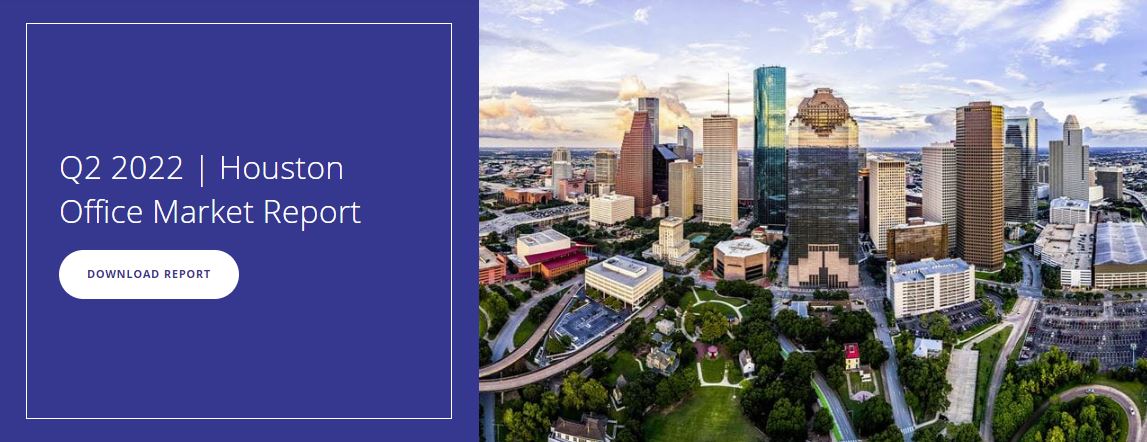Commercial Real Estate Research & Forecast Report
“The office market, more than any other sector, is still dealing with occupiers grappling with long-term adjustments brought on by work-from-home shifts in the workforce and short-term concerns over the direction of the economy. The result is that larger organizations have been quiet, and most of the leasing activity has been with smaller, private companies. The larger organizations, which can best move the occupancy needle, are on the sidelines for now. Construction issues have improved slightly since Q1, and we expect continued improvement in that area for the balance of the year.” Patrick Duffy, MCR President, Houston
| Key TakeawaysHouston office market records negative net absorptionVacancy up marginally by 10 basis pointsLeasing activity remains steady over quarterClass A occupiers gravitate toward newer product |
| Houston Highlights Houston’s office market posted negative net absorption in Q2 2022, recording -224,211 square feet. The overall average vacancy rate rose marginally by 10 basis points between quarters from 23.4% to at 23.5%. Office inventory remained unchanged, as no new inventory was added and there is 2.0 million SF of office space under construction. Average rental rates increased over the year. Houston’s Class A overall average full service rental rate rose from $35.10 per square foot in Q2 2021 to $36.29 per square foot in Q2 2022. Leasing activity remained steady over the quarter, recording 2.9 million square feet, which includes renewals. |

Houston Highlights
Houston’s office market posted negative net absorption in Q2 2022, recording -224,211 square feet. The overall average vacancy rate rose marginally by 10 basis points between quarters from 23.4% to 23.5%. Office inventory remained unchanged, as no new inventory was added and there is 2.0 million SF of office space under construction. Average rental rates increased over the year. Houston’s Class A overall average full service rental rate rose from $35.10 per square foot in Q2 2021 to $36.29 per square foot in Q2 2022. Leasing activity remained steady over the quarter, recording 2.9 million square feet, which includes renewals.


Executive Summary
Commentary by Rob Johnson | Vice President
While overall office vacancy in Houston’s Class A buildings currently exceeds 25%, newer Class A buildings continue to show strong absorptions trends, leaving a wake of opportunity for prepared and informed office users.
Many real estate publication headlines will quickly lead readers to statistics outlining the vacancy rate of office buildings in Houston. According to statistics from our data sources, the current Class A office vacancy across all of Houston is 25.7%, however, this can be a misleading statistic.
Organizations that continue to show firm commitments for in-person office presence have indicated their desire for premium facilities. Justification can range from employee recruitment and retention to maintaining an image.
When looking at Class A occupancy of properties larger than 100,000 RSF delivered to the market in the last ten years, an alternate picture emerges. Across all Houston submarkets, this younger asset class has a vacancy rate of 13.9%, a statistically significant decrease from the 25.7% for all Class A buildings. This data set’s occupancy and absorption trends suggest a more competitive market for newer Class A product.
Additionally, several large Class A buildings have been delivered to Houston’s CBD in recent years. It is important to consider that these buildings will likely need some time to accurately determine their effect on the market and if they will further exacerbate the trend of movement from legacy Class A properties to newer product. When users maintain the same occupancy footprint when relocating, the absorption net result is marginal. Still, it is important to note what asset class the occupiers were vacating and which buildings they are gravitating toward.
Lease commitments at the newer Class A buildings have created an opportunity in some legacy Class A assets where owners compete for tenants to fill available space and maintain existing tenants. Many of the legacy Class A assets have undergone, or are in the process of, large capital projects to provide or improve the amenities tenants have come to expect from Class A buildings. In addition, many landlords are providing concession packages that enhance their attractiveness to existing occupants to maintain their tenancy as well as to attract new potential users considering a different location.
For tenants to capitalize on the opportunities in the current office market, two key factors will play a significant role: 1) knowledge of which landlords and assets are willing to provide rich concession packages, and 2) the creditworthiness of the occupier. With proper direction, strong credit tenants will likely find amenity-rich buildings with economic concession packages that will not likely be seen again until the next tenant-friendly market cycle – perhaps years from now.




